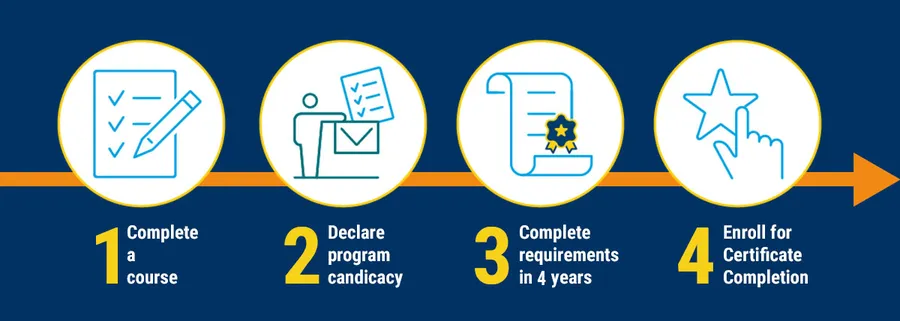
Linux Programming and Administration
The operating system of choice
CONTACT US
certificate Description
Program Retirement
Thank you for your interest in the Linux program. You are invited to enroll in any open course and pick up the practical skills you need. Please note, however, that we are no longer accepting new candidates for this program due to its pending retirement on Aug. 31, 2024.
Master Linux—the operating system of choice
In our Linux Programming and Administration professional certificate program, you learn both the core and advanced Linux skills you'll need to work on servers, network infrastructure, embedded systems, and mobile devices at top companies in Silicon Valley.
You'll receive individualized training for real-world applications in our unique courses—many of which are not available in traditional colleges.
Dive into topics like fundamental installation techniques and advanced system kernel customization tools. Customize your Linux learning journey to align with your personal interests and career aspirations.
Choose your emphases of study
Linux System Administration—Track 1
In the Linux System Administration track, you’ll get a solid foundation in configuring, operating, and administrating open, multi-user, multi-tasking Linux operating systems.
Linux System Development—Track 2
In the Linux System Development track, you’ll learn skills you’ll need to customize and optimize processes, IOs, and kernel modules. Linux Programming and Administration certificate program objectives
Linux Programming and Administration certificate program objectives
- Master shell commands and shell scripting in the Linux operating system
- Develop software programs and applications tailored for Linux, leveraging Linux system calls
- Build competence in managing, maintaining, updating, and supporting Linux installations
Our Linux students
- Software developers wanting to enhance programming knowledge
- Entry-level or career changers looking to enter the software development or support fields
- IT support staff wishing to expand their knowledge of Linux
- People interested in developing open source applications or advancing the Linux operating system and manage multiple VMware ESXi hosts and virtual machines using the vCenter Server
Program Overview
Estimated Cost: Track 1 starts at $3,595. | Track 2 starts at $3,800. (You pay only for courses you enroll in.) | International Tuition Cost
Program Requirements: 5-6 courses (14 quarter units). Take 1 required course (3 quarter units), 1 core course (2-3 quarter units) and 2-3 elective courses (8 quarter units). [Only 1 programming course may be applied to the certificate.] End with Certificate Completion Review.
Minimum Hours of Instruction: Minimum 140 hours of instruction.
Estimated Duration: A full-time student can complete the certificate in 9–12 months.
Modality: You can complete this program fully online, in person, or choose a mix of course formats.
Special Programs: This program is not approved for workforce or international students.
Courses
1. Required Course(s): Track 1 - Linux System Administration
2. Core Course(s): Track 1 - Linux System Administration. Complete one programming course.
3. Electives: Track 1 - Linux System Administration (8-9 units required)
4. Required Course(s): Track 2 - Linux System Development
5. Core Course(s): Track 2 - Linux System Development. Complete one programming course.
6. Electives: Track 2 - Linux System Development (8 units required)
7. Completion Review:
Meet Our Instructors
Certificate Inquiry Form
Recommended Course Sequence
Start with Linux, Introduction
If you have limited or no UNIX or Linux experience, we strongly recommend that you begin with Linux, Introduction.
Choose your certificate program track.
- Linux System Administration—Track 1
- Linux System Development—Track 2
Both tracks are 14 units each.
- Required Courses: 6 units (2 courses)
- Programming Course: 2–3 units (1 course) You may take as many programming courses as you want, but only one counts toward your Linux certificate.
- Electives: Varies. 5–6 units (2-4 courses) You must complete enough electives for a total of 14 units overall.
Substitutions
Shared credits
Some Engineering and Technology courses may be listed in more than one program. However, only one course may be shared between two E&T certificate programs unless otherwise noted.
To receive your certificate
Professional Development
Licensure and Certification
Developers and system programmers in the Development Track learn to customize and optimize processes, IOs and kernel modules. Our virtual server courses can also prepare you for optional VMware professional certification exams.
Please see our Licensure and Certification Policy to learn more.
Requisite Knowledge
Please review the course descriptions to ensure that you have taken necessary prerequisites or meet the requirements through job experience or previous education.
Establish Candidacy
Grade Requirements
Please note that only letter grades of C or higher may be applied to a certificate, and in some programs, students may have more stringent requirements. Students in most employer- and government-sponsored payment programs, such as workforce development, as well as international students on F-1 visas, need to maintain a B average to meet their requirements. Personal Financial Planning students have additional grade requirements for individual courses to attain a certificate.
See Grading and Credits Policy for further information.















